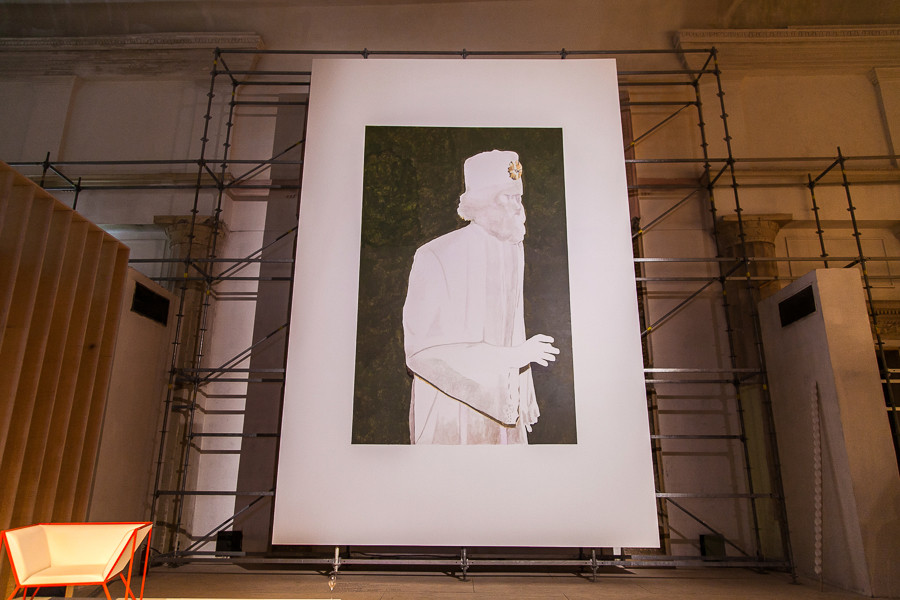The Worshipper
For the 6th Moscow Biennale Luc Tuymans had materialised one of his largest paintings ever. Because he was unavailable for the ten days of the exhibition, he came a week prior. His work was therewith the first work to be realised and a starting point for the whole of the Biennale. Bart de Bare reflects on Tuymans' project.

For these large-scale in situ wall paintings Tuymans has a specific way of engaging assistants. Many artists, also painters, work with studio assistants who execute (part of) the work. The Antwerp baroque painter Rubens even had four different price categories depending on the amount of work he himself invested in it. In the case of Tuymans the artist is the only one who is painting, but the role of his assistants — accomplished artists in their own right — is therefore no less important. They function as the artist’s additional eyes. They may give indications from their respective positions, so that the work ends up being made under the scrutiny of different perspectives and distances. The challenges that are addressed in this way are of pictorial nature, such as the degree of differentiation and sameness of different zones in the green background of the painting, or the play of the purple hues in the dress of the figure.
As always with Tuymans, the focus is not on how much more might be done but rather on how less done may strengthen the work. The central element is the hand. It remains in the white of the primary layer, only the outlines of a shape that seems to be trying to express something, an uncannily ambiguous gesture.
Luc Tuymans is an artist who continuously researches the intertwining of representation and presence. He does not invent images but interprets and positions them in such a way that they get a proper capacity, in between thematic and pictorial meaning. The images that were the starting point are often first unbalanced by an intermediary image. For some time he took Polaroid photos of the images he wanted to work with, and based his work on those, the deviations of their shabby quality informing him as much as the initial starting point.
Here, the foundation was a bad quality reproduction of a painting he did himself in 2004, ‘The Worshipper’, that was earlier also turned into a silkscreen realised on the occasion of the appearance of a special edition of the Phaidon monograph dedicated to the artist. The work in Moscow is cropped in relation to the earlier ones: the Christmas tree that was previously visible on the right has been left out. The proportions of the image are not standard, the painting is a bit more narrow — or proportionally higher — than would usually be the case. Because of this, the format may remind one of a main altar painting in a Catholic church.
The figure of a priest of an unspecified faith now stands isolated, a figure that is in a luminous state of fading out within his frame, with a hand that stretches to the whiteness of the surrounding of the wall, or the wider world. Initially, before entering the hall through the vast entrance arch, the visitors only see the bottom part of the body with the hand. As one moves, the head and the shoulders of the figure hovering over the theatre and the tent-like pavilion that houses Kostja Zvezdochotov’s Egyptian Museum become visible.
Even if it is obviously possible to connect the subject matter of ‘The Worshipper’ to the primacy of the Russian Orthodox church and its Patriarch, the work can also be connected to religion in an entirely different way; not to the dominant presence of the church, but to the spiritual as related to transience and disappearance.
When I shared with Daria Lihovitskaya — one of the producers of the Biennale — my sense that this painting generates a strong sense of location, reminiscent of a figurative Kazimir Malevich painting that used to feel like the centre of Paris to me in the former collection hanging of the Centre Pompidou, she responded by saying that this is because this painting allows the visitors to have a personalised experience, that’s why people will remember it. This is true, the work can be experienced only as an embodied painting. When one approaches the lower part of the figure, it opens itself up as grounded in precise and quite decisive brush strokes.
The impression of a relation to Malevich may also be an outcome of the character of the brush strokes. In both of these artistic spaces, that of Malevich and that of Tuymans, the brush strokes do not testify to an artist realising an art work, they are the witnesses of detachment as an expression of commitment, commitment to an image that needed to be realised.
